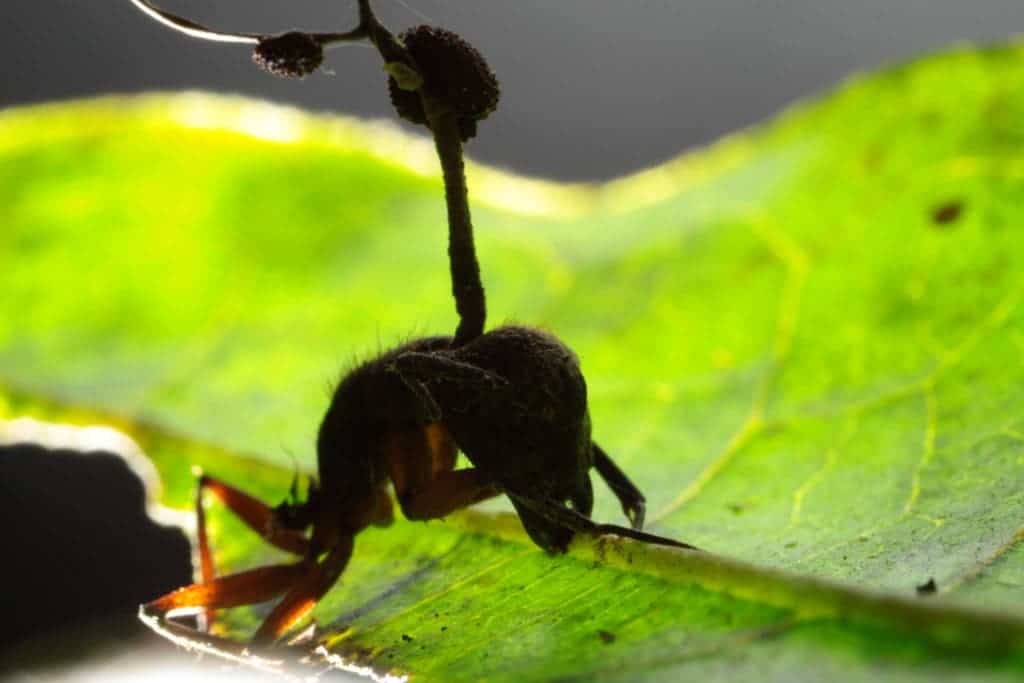The so-called zombie fungus, which boasts one of the most bizarre and cruel survival strategies, has also been affected by climate change, researchers have found.

The parasitic fungus Ophiocordyceps kimflemingiae is often called the zombie fungus, and for good reason: it targets a specific host species (a carpenter ant), and forces it to drastically change its behavior. The spores of the fungus attach and eventually break through the ant’s exoskeleton using mechanical pressure and enzymes to spread through the ant’s body. The fungus then forces the ant to climb up the stem of a plant and use its mandibles with abnormal force to secure itself to a leaf vein. After the ant clamps on to the leaf, the fungus starts to basically dissolve the ant’s muscles while continuing to fortify the lockjaw position. The fungus kills the ant, and, when it’s ready to reproduce, it sprouts new spores from the ants head, starting a new cycle.
This gruesome process is not limited to a single species — about half of the carpenter ants can get infected by a mushroom parasite, and each species of carpenter ant has its own type of fungus. There are some differences between the different zombie fungus species, researchers say.
In tropical areas, zombie ants bite onto leaves, but in temperate areas, they bite twigs or bark,” said David P. Hughes, associate professor of entomology and biology at Penn State.
The mechanisms by which the fungi control the ants are generally similar, but the differences are generated by the types of vegetation around, which in turn is mostly controlled by climate. Tropical forests are almost completely evergreen, for instance, while most temperate forest trees drop all their leaves in the fall.
“In the late summer and early fall there are both leaves and twigs everywhere the ants reside,” said Raquel G. Loreto, postdoctoral scholar in entomology, Penn State. “But in temperate areas the trees are deciduous and lose their leaves in the fall. There, the ants bite onto twigs.”
The team found that as the climate shifts, so too does the behavior of the zombie fungus as well as their victim, the ants. First, they determined that tropical zombie ants always bite leaves while temperate zombie ants always bite twigs and bark. They also noted that 90% of the dead temperate ants discovered have their legs wrapped around the twigs. The ancestral feature (the one which dictates this behavior) was established to be leaf biting, rather than twig biting, as the fungus seems to have originated from warmer areas.
The work involved a great deal of field work and, once again (as it so often seems to happen in recent times), a citizen scientist was essential to the success of the study.
“We had a great asset here who is Kim Fleming,” said Hughes. “Kim is a citizen scientist whose property in South Carolina is festooned with zombie ants hanging on trees. As both an excellent photographer and natural historian, Kim was able to collect detailed data for us on the zombie ants over 18 months by taking continual images of samples on her land. This was precious data that would have been very hard to collect.”wh
Kim’s impact was so significant that a species was actually named after her, which is, indeed, a rare honor.
“Kim is an author of this paper, but perhaps the greatest recognition of her importance is that the fungal species infecting carpenter ants in South Carolina is now named after her, Ophiocordyceps kimflemingiae.”
Researchers also found fossils which indicate that the zombie fungus emerged at least 20 million years ago, although they are potentially much older. However, because of the fragility of both the fungus and the ant, fossils are few and far between — researchers were lucky to find a German fossil of an ant biting a leaf in a similar manner to today’s zombie ants.
What’s interesting is how the fungus found a way to adapt. Whenever climates change, all creatures are forced to either adapt or perish. It’s impressive that the zombie fungus adapted so well to the changing environment, managing to update their manipulation of ants, which ensured their survival up to today.
“What is remarkable here is that we have shown that the complex manipulation of an animal by microbe has responded to selection pressure the climate imposes on animals and plants,” said Hughes. “That was a cool finding that really excited us.”
The study has been published in Evolution.


